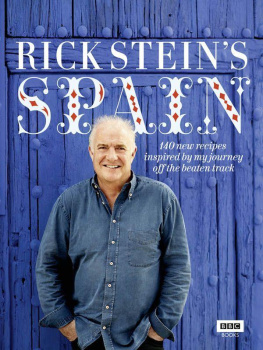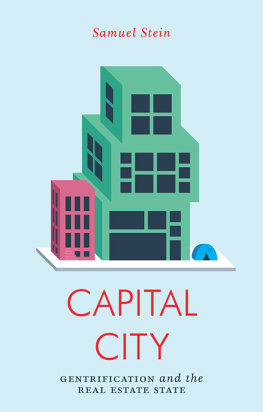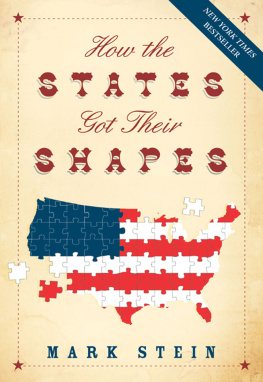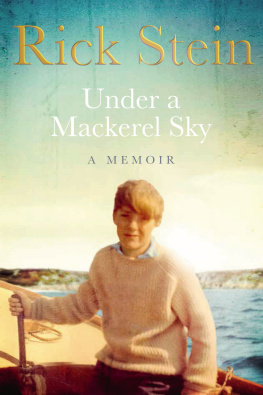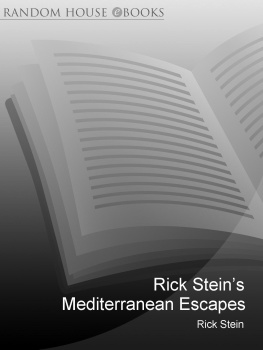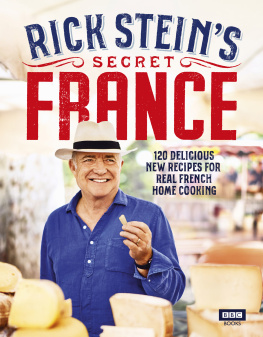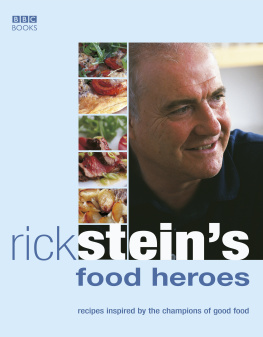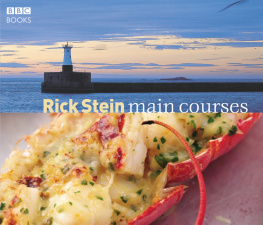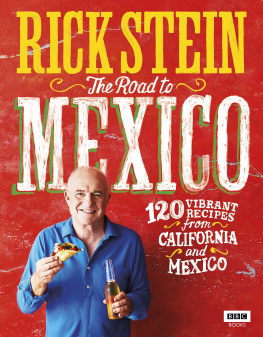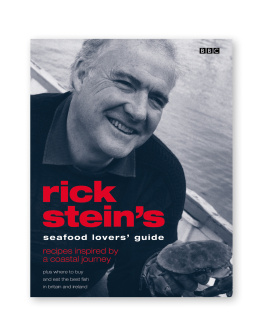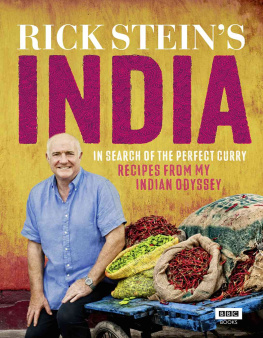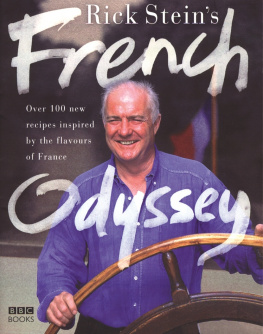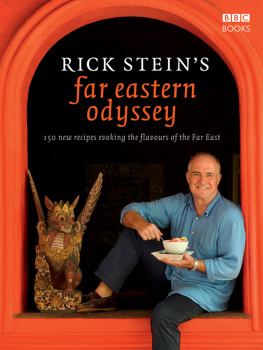CONTENTS
Chapter One
GALICIA
Chapter Two
ASTURIAS & CANTABRIA
Chapter Three
BASQUE COUNTRY
Chapter Four
RIOJA & NAVARRA
Chapter Five
CATALONIA
Chapter Six
VALENCIA
Chapter Seven
CASTILLA LA MANCHA
Chapter Eight
EXTREMADURA
Chapter Nine
ANDALUCA
Chapter Ten
SPANISH DESSERTS
About the Book
Nostalgic for his childhood holidays and the unforgettable, simply prepared food he enjoyed there, Rick Stein has wanted to rediscover Spain for a long time.
In this beautiful cookbook to accompany his journey off the beaten track, Rick has created over 14 mouthwatering recipes that capture the flavours of Spain today. Illustrated with outstanding photography of the Spanish regions, their local people and diverse food traditions, and brought to life with vivid anecdotes from Ricks travels, this evocative book will appeal to food lovers and conjure up images of vibrant Spanish holidays.
About the Author
Rick Steins passion for using good quality local produce and his talent for creating delicious flavour combinations in his books and restaurants have won him a host of awards, accolades and fans. As well as presenting a number of television series, he has published many best-selling cookery books, including French Odyssey, Mediterranean Escapes, Coast to Coast and Far Eastern Odyssey .
Rick is a firm supporter of sustainable farming and fishing techniques, which he strives to maintain in Padstow, Cornwall, where he runs four acclaimed restaurants and a seafood cookery school, as well as a delicatessen and patisserie. In 2003 Rick was awarded an OBE for services to West Country tourism. He divides his time between Padstow and Australia, where he opened a restaurant, Rick Stein at Bannisters, in 2009.
List of Recipes

This book is dedicated to Edward, Jack and Charles and Sarah, Zach and Olivia.

If you go to La Corua, theres a place I think you should visit. It wont fill you with a sense of modern Spain, the country that dazzles the eye with its forests of electricity-generating windmills on the tops of hills, its new motorways with dark blue crash-barriers and dizzying spaghetti intersections with just-completed roads that sometimes seem to be going nowhere. Neither will it give you a shred of information about the new Spanish cooking, with its emulsions of roasted piquillo peppers and foams of langoustines. This place does octopus and, not unnaturally, its called Mesn do Polpo; its in the Calle de la Franja, a narrow street packed with little seafood restaurants whose names hardly seem to matter, though if youre doing a bit of a tapas trek, theres another one called Mesn o Galego, which has very wobbly tables and is rated by the locals as the best in Galicia. Do Polpo specializes in pulpo a la feria, slices of tender octopus boiled in salted water and served on a pine platter sprinkled with extra virgin olive oil, sea salt and pimentn, the smoky paprika from La Vera in Extremadura, which is the most distinctive flavour of Spanish food. I cant think of any dish in Spain I enjoy more, especially with a glass of albario wine or, if Im feeling very local, a white bowl of cloudy Ribeiro.
I might also have mentioned a tapas bar a few streets away called La Traida. It was run by two sisters, Mari Carmen and Sisi, in their seventies. They took over when their father died and ran it for fifty years. I went there last February. Now its gone. The Galician beer was ice-cold and their tuna empanadas were pretty special, as were the slices of tetilla cheese which, when whole, come in the shape of a small breast. As is often the way in such old bars, the floors were uneven flagstones and the walls adorned with pictures of Galician rias, sunken valleys flooded by the sea where a lot of Galician seafood is caught or farmed. There were pictures of King Carlos and Queen Sofia, and lots more of their own, much-loved father. Such places are going fast, replaced by modern bars or clothes shops.
My Spain is fixed in those older places. I first went there in 1955, to Cantabria; the Civil War had finished only sixteen years earlier. Childhood memories are so strong. I remember the poverty, the shock of seeing that the fishermen had no toilets. And the Guardia Civil, the national police, were everywhere in the countryside, standing motionless, watching the roads with their grey uniform and distinctive black two-cornered hats. One of them roughly pushed me back into the crowd at the annual Battle of the Flowers in the fishing port of Laredo where we were staying, and that, and the darkness of Burgos cathedral, seems like yesterday. I can still see the frighteningly lifelike images of Jesus battered on the cross, the galloping statue of El Cid outside with sword outstretched, and his coffin high on the wall inside. On the way back from Burgos to Laredo there were griffon vultures circling high above the mountains. All formed a slightly grim but romantic view of Spain that I cant shake off. It was still a world to which the English author Laurie Lee walked out one midsummers morning in 1934 and found a poor but beautiful country, a landscape pure as the sea, ancient, wind-ravaged and bare, isolated from the rest of Europe by the Pyrenees and a history of ardent Catholicism brought about by a fanatical desire to build a Christian nation after eight hundred years of Moorish rule. This influence of the church, and the riches and produce from the Americas potatoes, tomatoes, chillies, tobacco were what made Spain what it was, so well personified in the character of Don Quixote. For although Cervantes wrote the book in the sixteenth century, not much changed until the Civil War. Quixote, the idealist, a man of quality but desperately poor, thinking of food all the time and dreaming of times past when knights performed dazzling acts of chivalry, setting out to put a baffling world to rights this seems to me to be how Spain was.

Since General Franco died in 1975, Spain has become a completely different country, prosperous, sexy even, and confident. Cities like Barcelona and Valencia are exciting places with entertaining architecture, like the all-glass Gas Natural building by the sea in Barcelona, which has part of its complicated mirror-like elevations built as though it has had a gigantic bite taken out of it by a shark. A marine theme results in the shimmering silver scales of the Guggenheim Museum in Bilbao, too, which has transformed a rather grey northern industrial city in the Basque country into somewhere stylish. Both buildings engage the viewer and give a sense of optimism and hope for the future. My problem is not that I dont enjoy this new Spain, its just that Im still imbued with memories of Spain over my lifetime. As an eight-year-old I had cuttlefish stewed in its own ink with garlic and tomato and I still remember it. Spanish cooking has been for me over the years a memory of simple but completely satisfying flavours. In the north, in what they call Green Spain, I think of the white thickness of a fillet of hake cooked in fragrant albario wine with peas and asparagus, or the cheerful acidity of Asturian cider, freshly aerated from being poured into a glass from a great height, and served with a tapas of fresh slices of monkfish, deep-fried in egg batter. In the Basque Country, I love the scent of charcoal on the rib of beef chops they grill rare and slice for you. I yearn for the plates of wild mushrooms quickly fried in olive oil then served with an egg yolk to stir in as a sauce in a pintxos bar in San Sebastin. In contrast, in the hot and dry south, there are the reds and yellows of the Spanish flag everywhere: the strong red wine from Rioja, the warm smoky red of pimentn, sweet tomatoes, the deep red of ibrico ham with its melting fat and the flecked lean with its slight grittiness and tartness, the orangey-red of spicy chorizos with yellow chickpeas or butter beans, and the colour of saffron and lemon, golden garlic and eggs. Eggs in tortillas, in soups and scrambled with asparagus, aubergine, tomato and courgette. With the slippery green of peppery olive oil and the scent of orange and orange blossom, you realize that the heart of Spanish food lies in the simplicity of the cooking and their belief in the quality of raw materials. Food for me is a memory of happy times in Spain tied in with thoughts of old musty cathedrals, vast horizons and fishing boats somewhere in the Mediterranean unloading wooden boxes of dark red prawns, a scent of fish scales, black tobacco and diesel in the air.

